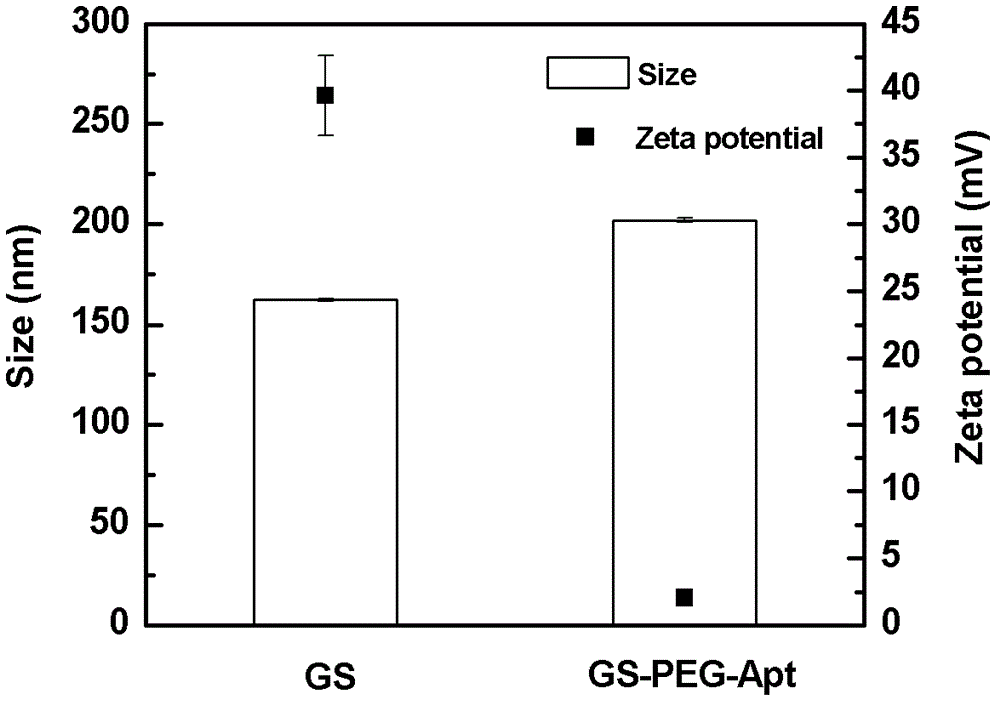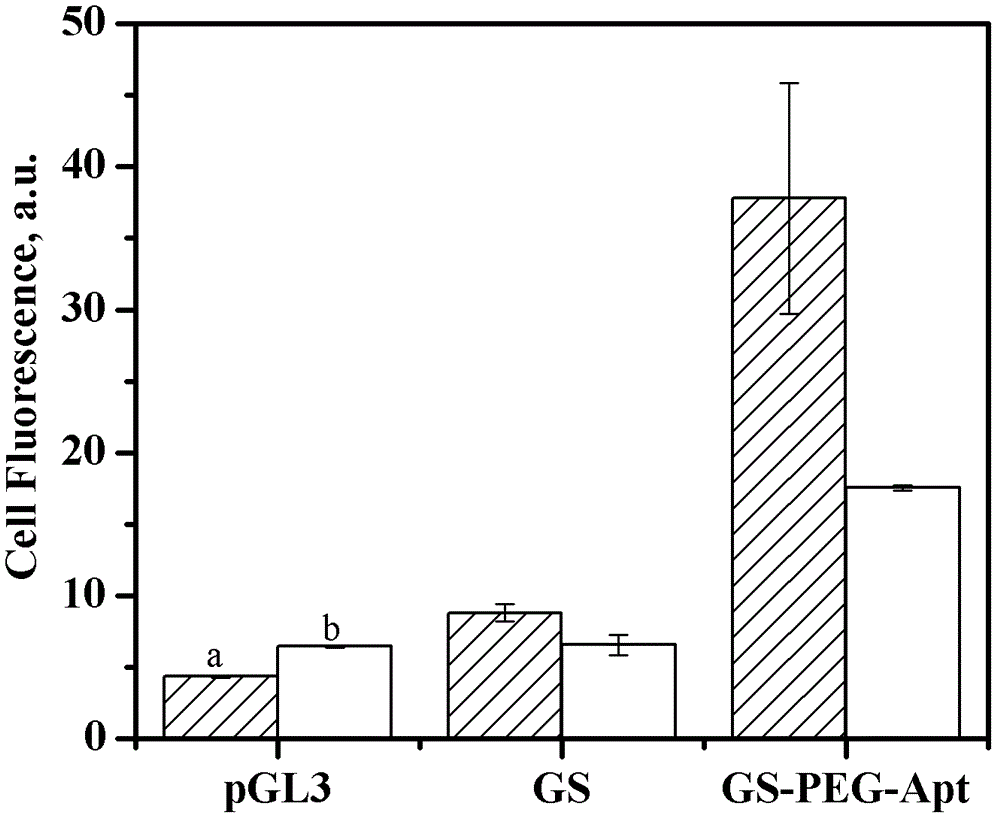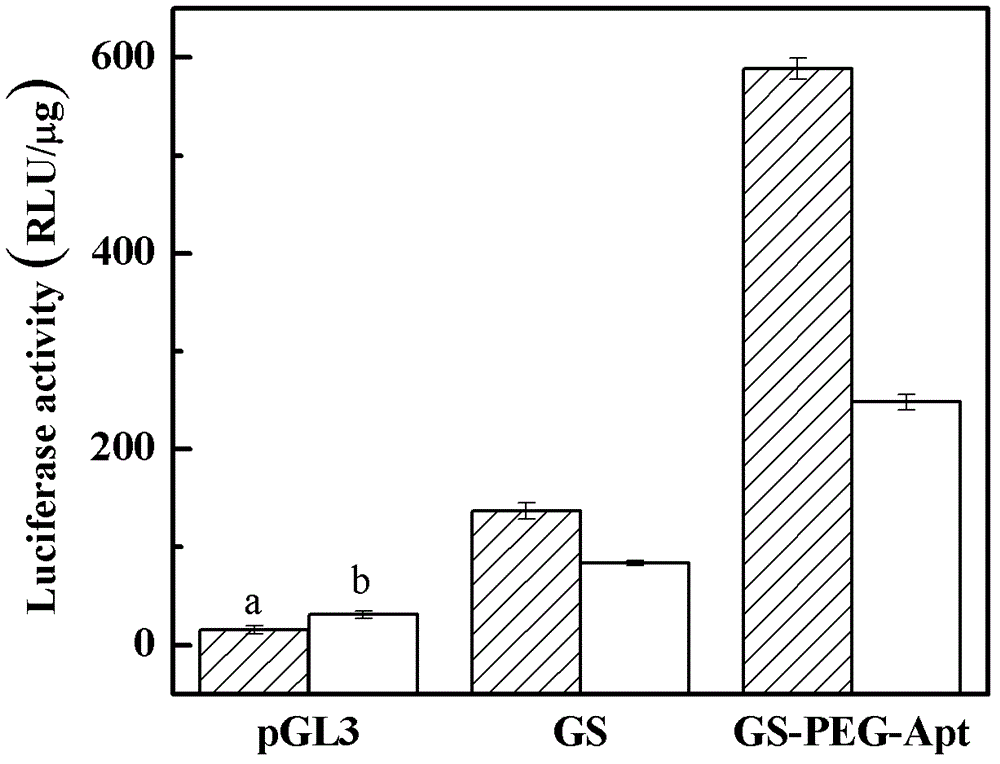Method for realizing surface modification of tumor targeted nonviral vector and application thereof
A non-viral carrier and surface modification technology, applied in the field of non-viral carrier, can solve the problem of limited application of clearance speed, achieve the effect of no immunogenicity, prolong circulation time, and no cytotoxicity
- Summary
- Abstract
- Description
- Claims
- Application Information
AI Technical Summary
Problems solved by technology
Method used
Image
Examples
Embodiment 1
[0034] 1) Preparation of gelatin-siloxane nanoparticles (GS)
[0035] Dissolve 0.2g of gelatin in 20mL of acetic acid solution with a pH of 3, and stir at 50°C for 30min. Then 0.2 g of 3-(2,3-glycidoxy)propyltrimethoxysilane was added to the above 1% gelatin solution. After the reaction solution was stirred and reacted at 30° C. for 6 hours, ammonia water was added to adjust the pH value of the solution to 9, and the stirring reaction was continued for 12 hours to obtain a milky white suspension. The milky white suspension was subjected to high-speed centrifugation (20,000 rpm, 15 min, 30° C.) to obtain a white precipitate. The white precipitate was washed twice with distilled water to obtain gelatin-siloxane nanoparticles (GS).
[0036] 2) Polyethylene glycol modified gelatin-siloxane nanoparticles (GS-PEG)
[0037] Add 1-ethyl-3-(3-dimethylaminopropyl)-carbodiimide (EDC), N-hydroxysuccinimide (NHS) and α- Amino-ω-propionyl-polyethylene glycol (NH 2 -PEG-COOH). EDC: NHS: ...
Embodiment 2
[0042] In sodium carbonate buffer at pH 8.0, add 1-ethyl-3-(3-dimethylaminopropyl)-carbodiimide (EDC), N-hydroxysuccinimide (NHS) and α -Amino-omega-propionyl-polyethylene glycol (NH 2 -PEG-COOH). EDC: NHS: NH 2 - The molar ratio of PEG-COOH is 4.5:4.5:1, shaken for 4h, and then mixed with GS dispersed in pH 8.0 sodium carbonate buffer to make NH 2 -PEG-COOH and the amino group on GS (-NH 2 ) in a molar ratio of 1:1. After continuing the shaking reaction for 4 hours, the milky white suspension was subjected to high-speed centrifugation (14,000 rpm, 20 min, 20° C.) to obtain a white precipitate. The white precipitate was centrifuged and washed three times with distilled water to obtain polyethylene glycol-modified gelatin-siloxane nanoparticles (GS-PEG).
[0043] Disperse GS-PEG in the sodium carbonate buffer solution of pH 8.0, add 3-(2-pyridine dimercapto) propionic acid n-hydroxysuccinimide ester (SPDP), make SPDP and the amino group on GS-PEG ( -NH 2 ) in a molar rat...
Embodiment 3
[0046] Preparation of fluorescence-labeled luciferase plasmid pGL3 and GS complex: uniformly mix the fluorescent marker propidium iodide (PI) with pGL3 plasmid in distilled water at a mass ratio of 0.7:1, and stand in the dark for 20 minutes at room temperature. A fluorescently labeled plasmid (pGL3-PI) was obtained. GS and plasmid pGL3-PI were mixed in distilled water at a mass ratio of 50:1 at 25°C, vortexed for 30 s, and then allowed to stand for 1 h to obtain a gelatin-siloxane nanocomposite suspension (GS / pGL3-PI).
[0047] In sodium carbonate buffer at pH 9.0, add 1-ethyl-3-(3-dimethylaminopropyl)-carbodiimide (EDC), N-hydroxysuccinimide (NHS) and α -Amino-omega-propionyl-polyethylene glycol (NH 2 -PEG-COOH). EDC: NHS: NH 2 -The molar ratio of PEG-COOH was 3:3:1, and the reaction was shaken for 4h, and then it was mixed with the GS / pGL3-PI nanocomposite dispersed in pH9.0 sodium carbonate buffer to make the NH 2 -PEG-COOH and the amino group on GS (-NH 2 ) in a mo...
PUM
 Login to View More
Login to View More Abstract
Description
Claims
Application Information
 Login to View More
Login to View More - R&D Engineer
- R&D Manager
- IP Professional
- Industry Leading Data Capabilities
- Powerful AI technology
- Patent DNA Extraction
Browse by: Latest US Patents, China's latest patents, Technical Efficacy Thesaurus, Application Domain, Technology Topic, Popular Technical Reports.
© 2024 PatSnap. All rights reserved.Legal|Privacy policy|Modern Slavery Act Transparency Statement|Sitemap|About US| Contact US: help@patsnap.com










